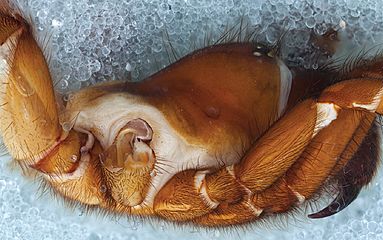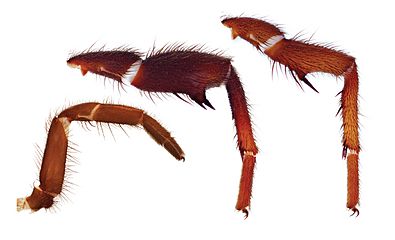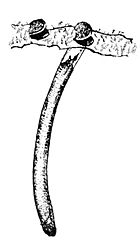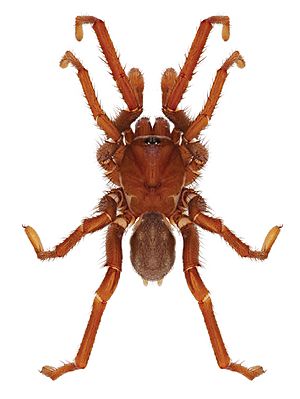Eucteniza facts for kids
Quick facts for kids Eucteniza |
|
|---|---|
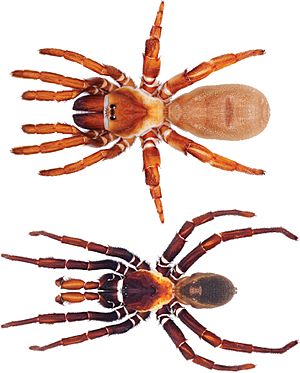 |
|
| Eucteniza relata, female (top) and male | |
| Scientific classification |
|
| Kingdom: | Animalia |
| Phylum: | Arthropoda |
| Subphylum: | Chelicerata |
| Class: | Arachnida |
| Order: | Araneae |
| Infraorder: | Mygalomorphae |
| Family: | Euctenizidae |
| Genus: | Eucteniza Ausserer, 1875 |
| Type species | |
| Eucteniza mexicana Ausserer, 1875
|
|
| Diversity | |
| 14 species | |
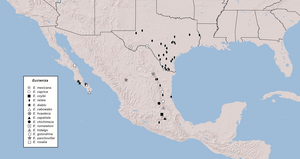 |
|
| Eucteniza species in North America | |
| Synonyms | |
|
|
Eucteniza (pronounced yook-tuh-NY-zuh) is a group of trapdoor spiders. These spiders belong to the family Euctenizidae. There are at least 14 known types (species) of Eucteniza spiders. They live in Mexico and the southern United States. You can tell these spiders apart by a soft spot on the back of their main body section. Male spiders also have big spines on their first two pairs of walking legs. They use these spines to hold onto the female during mating. Like other trapdoor spiders, they build burrows with a hinged lid. From these burrows, they wait for insects and other small creatures to walk by, then they pounce! Many types of these spiders are only found in one or two places. Sometimes, scientists have only found male spiders of a certain type. This means there are likely more kinds of Eucteniza spiders waiting to be discovered! Eucteniza spiders are related to other spiders like Entychides and Neoapachella.
Contents
What Do Eucteniza Spiders Look Like?
Eucteniza spiders can grow up to about 2.75 centimeters (1.1 inches) long, not counting their legs. This makes them quite large for spiders. Their main body section, called the cephalothorax, is oval-shaped. It is a bit longer than it is wide. This part of their body holds their eyes, mouthparts, and legs. The back third of their top shell (carapace) is soft and lighter in color. This shell often has no hairs, but some types have black bristles around the edge.
These spiders have eight eyes. The eyes are not raised and are set in two rows in a rectangle. The back row curves slightly upwards, like a shallow bowl. The front row curves slightly downwards, like an upside-down bowl. Eucteniza spiders come in different shades of brown. Males are usually a dark reddish-brown. Their jaws (chelicerae) are dark brown. Sometimes, their back body part (abdomen) has a dark brown blotch on top. The length of their main body section varies. It can be as small as 0.35 cm (0.14 in) in E. huasteca or as large as 1.15 cm (0.45 in) in E. relata.
Male Eucteniza spiders have swollen or enlarged fifth leg segments (tibiae) on their first and second walking legs. They also have one or two large spines on these legs. These are called "mating claspers." Other related spiders only have these claspers on their first pair of legs. The size, number, and way these spines are arranged are different for each type of spider. Female spiders have a special double-toothed groove where their fangs fit. No other spider in this family has this. Both male and female spiders also have "preening combs." These are rows of stiff bristles on their back legs.
How Do Eucteniza Spiders Live?
Like other trapdoor spiders, Eucteniza spiders build burrows in the ground. These burrows have a lid that opens and closes like a hinge. They wait inside to ambush any prey that walks by. Scientists have studied the burrows and hunting habits of E. relata. Other types of Eucteniza spiders are thought to act in a similar way.
The burrow is a single tube lined with silk and soil. It can be from 7 to 25 cm (2.8 to 9.8 in) deep. The burrow is covered with a lid that looks like a cork. This lid is made of silk and soil and has a silk hinge. The bottom of the burrow collects old exoskeletons (shed skins) and parts of prey. Their prey includes beetles, ants, and millipedes. Scientists have found burrows of adult and young spiders close together. This suggests that young spiders do not move far from where they hatch. In Texas, these spiders leave their burrows to find mates between August and January. This is when they are most often seen. In Mexico, this time is from June to January.
Where Do Eucteniza Spiders Live?
Eucteniza spiders mainly live in the deserts and dry tropical forests of Mexico and Texas. They have been found at low elevations, about 8 to 12 meters (26 to 39 feet) above sea level. This includes types like E. cabowabo, E. diablo, and E. rosalia in Baja California. They have also been found at high elevations, around 3,300 meters (10,800 feet), like E. relata in northeastern Mexico. Their burrows are found on flat ground or gentle slopes. In southern Texas, E. relata might even dig burrows in people's lawns. You might see them more often after it rains. Eucteniza spiders are generally hard to find in nature. They are also rare in museum collections.
Who Hunts Eucteniza Spiders?
In Texas, E. relata spiders are thought to be hunted by tarantula hawk wasps. These wasps are in the group Pepsis. Tarantula hawk wasps are known to sting and paralyze tarantulas and other spiders. They do this to provide food for their young. Scientists have seen female Pepsis wasps looking for Eucteniza spiders. They sting the spiders inside their burrows, leaving them paralyzed there.
How Scientists Study Eucteniza Spiders
The history of naming and classifying Eucteniza spiders is quite detailed. There have been almost 20 named types and four different group names (genera). Three of these group names are now considered the same as Eucteniza. Also, several named types of spiders have been found to be the same as types described earlier.
The group name Eucteniza was first used by an Austrian scientist named Anton Ausserer in 1875. He described the spider Eucteniza mexicana. Later, in 1895, an English scientist, Octavius Pickard-Cambridge, described new groups called Favila and Enrico. He named new spiders relatus and mexicanus for these groups. Soon after, his nephew, Frederick Octavius Pickard-Cambridge, moved F. relatus to the Eucteniza group. This made Favila a junior synonym of Eucteniza (meaning it's an older name for the same group). In 2002, Enrico mexicanus was also found to be the same as Eucteniza. To avoid confusion with Ausserer's Eucteniza mexicana, Enrico mexicanus was given a new name: Eucteniza atoyacensis.
In 1940, an American biologist, Ralph Vary Chamberlin, described a new group and spider, Astrosoga rex, from Texas. At the same time, Willis J. Gertsch and Stanley Mulaik described A. stolida, also from Texas. Both of these Astrosoga spiders were moved to the Eucteniza group in 2002.
Many changes to the classification happened in 2013. American biologists Jason Bond and Rebecca Godwin reviewed the spiders. They described twelve new types of Eucteniza spiders. Many were named after nearby places, native peoples, or famous Mexican historical figures. Some were even named after the nightclub Cabo Wabo or a character from the TV show Battlestar Galactica. Both E. rex and E. stolida were found to be the same as E. relata. Also, E. atoyacensis (which was Enrico mexicanus) was called a dubious name. This means it's unclear if it's a distinct type because it was first described from a young spider. So, as of 2013, there are 14 recognized types of Eucteniza spiders.
Different Types and Where They Live
The different types of Eucteniza spiders are identified by their body size, leg proportions, number of leg spines, and the shape of the female spider's sperm storage organs (sperm receptacles). Their geographic location also helps tell them apart. Most types are only known from male spiders. However, E. rosalia and E. panchovillai are only known from female spiders.
Eucteniza spiders live across central and northern Mexico, much of Texas, and the lower part of the Baja Peninsula. Many types are only known from their type locality. This is the exact place where the first spider specimen was found. The type with the largest range is E. relata. However, scientists Bond and Godwin believe that E. relata might actually be several cryptic species. These are distinct types that look very similar. More research, like studying their DNA, will be needed to tell them apart.
| Species | Geographic range T means only known from type locality. Source: Bond & Godwin 2013 unless otherwise noted |
Meaning of the name Source: Bond & Godwin 2013 unless otherwise noted. |
|---|---|---|
| Eucteniza cabowabo Bond & Godwin, 2013 | La Paz and Los Cabos areas, Baja California Sur | Named after the restaurant Cabo Wabo in Cabo San Lucas, Mexico. |
| Eucteniza caprica Bond & Godwin, 2013 | Tamaulipas, MexicoT | Named after Caprica 6, a robot character from the 2004 Battlestar Galactica TV show. |
| Eucteniza chichimeca Bond & Godwin, 2013 | Querétaro, MexicoT | Named after the native Chichimeca Jonaz people. |
| Eucteniza coylei Bond & Godwin, 2013 | Morelos, MexicoT | Named after Fred Coyle, a spider scientist who found the first specimen. |
| Eucteniza diablo Bond & Godwin, 2013 | La Paz Municipality, Baja California Sur | Named after Picacho del Diablo, the highest mountain peak in Baja. |
| Eucteniza golondrina Bond & Godwin, 2013 | Sótano de las Golondrinas, San Luis Potosí, MexicoT | Named after the place where it was first found. |
| Eucteniza hidalgo Bond & Godwin, 2013 | Hidalgo, MexicoT | Named after the place where it was first found, and also for the Spanish word for noble. |
| Eucteniza huasteca Bond & Godwin, 2013 | La Huasteca Canyon, Nueva Leon, MexicoT | Named after the place where it was first found. |
| Eucteniza mexicana Ausserer, 1875 | Known only from a specimen from Mexico City and the first specimen, whose location is simply "Mexico". | The name Mexicanus is Latin, meaning Mexican. |
| Eucteniza panchovillai Bond & Godwin, 2013 | San Juan del Rio, Durango, MexicoT | Named after the Mexican revolutionary Pancho Villa, who was born in San Juan del Rio. |
| Eucteniza relata (O. Pickard-Cambridge, 1895) | Found throughout northern and central Mexico, and into central Texas. | The name Relatus is Latin, meaning returned or reported. |
| Eucteniza ronnewtoni Bond & Godwin, 2013 | Val Verde and Brewster counties, Texas | Named after Ronald Newton, a biologist from Texas. |
| Eucteniza rosalia Bond & Godwin, 2013 | Mulegé, Baja California Sur, MexicoT | Named after the Río de Santa Rosalía (Santa Rosalia River). |
| Eucteniza zapatista Bond & Godwin, 2013 | Paso de Cortes, Puebla, MexicoT | Named after the Zapatistas, who were members of Mexico's Liberation Army of the South. |
How Eucteniza Spiders Are Classified
Eucteniza is the main group (type genus) for the family Euctenizidae. These are also known as "wafer trapdoor spiders." This family of spiders used to be considered a smaller group within the Cyrtaucheniidae family. Within the Euctenizidae family, Eucteniza is part of the Euctenizinae subgroup.
Earlier studies looked at how these spiders looked and behaved. They suggested that the closest relative to Eucteniza was Neoapachella rothi. This spider lives in forests in Arizona and New Mexico. More recent studies, including looking at DNA similarities, suggest a closer link to Entychides. This group has several types of spiders found from Arizona to Texas and into Mexico.
See also
 In Spanish: Eucteniza para niños
In Spanish: Eucteniza para niños


